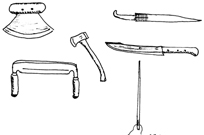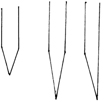Alaska Science Camps, Fairs & Experiments
ANKN is a resource for compiling and exchanging information
related to Alaska Native knowledge systems and ways of knowing. We
are pleased to create and distribute a variety of publications
that assist Native people, government agencies,
educators and the general public in gaining access to the knowledge
base that Alaska Natives have acquired through cumulative experience
over millennia.
TO ORDER THIS PUBLICATION:
Contact the ANKN
offices at 907-474-1902 or email uaf-cxcs@alaska.edu.  Sharpening Sharpening
Throughout the centuries, the ability to
sharpen tools has been a matter of great importance to Alaskans.
 Today
we have a variety of knives, and a variety of sharpening tools. Each
has its own purpose. A good experiment will determine the application
of each. A knife that is good for skinning beaver would be almost
worthless to cut salmon. A knife that is good for butchering a walrus
is undesirable for carving a wooden spoon. Today
we have a variety of knives, and a variety of sharpening tools. Each
has its own purpose. A good experiment will determine the application
of each. A knife that is good for skinning beaver would be almost
worthless to cut salmon. A knife that is good for butchering a walrus
is undesirable for carving a wooden spoon.
Four Variables
There are four variables in sharpening a tool:
- Material to be cut: Cutting meat and fish are quite
different from carving wood.
- Type of steel, shape of the blade and shape of the tool:
There are many types of steel in cutting blades, each one with
advantages and disadvantages.
- Sharpening instrument: Files, stones and steels are all
different. Each has its applications.
 Thickness
of the edge: A thin edge will act differently from a thicker
one. There are different shapes of the edges: smooth, serrated,
flat on one side, or beveled on both. An edge too thin will break
off easily . An edge too thick will not penetrate easily. Thickness
of the edge: A thin edge will act differently from a thicker
one. There are different shapes of the edges: smooth, serrated,
flat on one side, or beveled on both. An edge too thin will break
off easily . An edge too thick will not penetrate easily.
VARIABLES INVOLVED IN SHARPENING A
KNIFE
|
Material to be
cut
Wood
Fish or meat
|
Type of Steel
in the blade
Soft steel
Hard steel
Stainless steel
|
Sharpening Instrument
|
File
|

|
Smooth
Coarse
|
|
Stone
|

|
Smooth
Coarse
|
|
Steel
|

|
Butcher steel
Diamond steel
Hunter's steel
|
|
Thickness of Edge
Thick edge
Thin edge
One sided edge
|
Try different combinations of the above. Find out which works best
under certain conditions. Example: When cutting fish, a knife with a
ver y hard blade might hold an edge longer , but it might be too
tedious to sharpen. A softer knife that can be quickly stroked with a
file might be better.
What kinds of steel ar e more efficient for different
applications? (Soft steel, hard steel, stainless steel, etc.)
Which works best on soft blades, hard blades, and stainless steel
blades: a file, a stone or a sharpening steel?
What is the best angle to sharpen a knife for meat, for fish, or
for wood? Which one penetrates better? Which one lasts longer?
Is a smooth edge better on wood or meat? Is a rougher edge better
on meat, fish or wood?
Explore
Look at a sharpening stone, both coarse and fine under a
magnifying glass. Describe and/or draw what you see.
Why do people use oil or saliva on the stone?
How is a used stone different from a new one?
How do electric grinding wheels differ from hand stones?
Look at different files under a magnifying glass. What do you see?
How are the teeth shaped?
Which files are faster? Course or fine?
Which ones smoother?
Under the magnifying glass, can you see the difference between a
dull file and a new one?
What materials plug a file? File brass, aluminum, steel, wood, and
other materials.
What materials dull a file?
Look at a butcher steels under a magnifying glass. What do you
see? What is the difference between a butcher steel and one
impregnated with diamonds?
Experiment with porcelain and diamond sharpeners.
Which is quicker and more effective for sharpening a hard blade: a
file or a stone? Gerber or Buck knives are hard. SchradeWalden is
softer steel.
Where did people in your area get sharpening stones in
traditional
times? The village of Sleetmute actually means "Village of the
Sharpening Stones." Oldtimers knew where to find them or trade for
them. Explore this in your region.
When old-time barbers sharpened the razor they stropped it on a
piece of leather. What do you think this accomplished? How is this
similar to the methods used by Native women when they cleaned
skins?
Sharpen a piece of slate on sandstone. Wet the slate regularly.
Then try to cut a fish with the slate edge.
I have found that learning how to create the proper edge for a
given job is a lifetime experiment, but one that pays off in smooth
effective cutting.
|